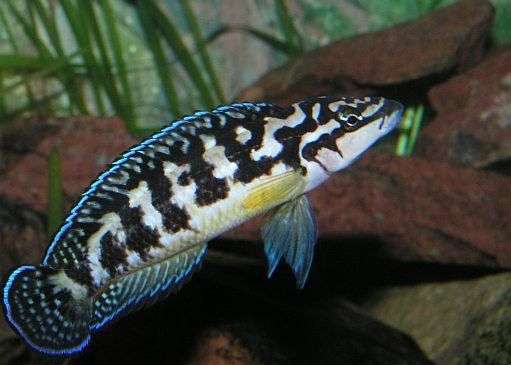
Size
It reaches 6 inches in length.
Physical Characteristics and Behavior
A fish with the J. ornatus’ appearance. The skin tones range from a light golden tint to one that is more vivid. It bears three brown and black lateral stripes on each side of its body. While the lowest starts at the base of the anal fin, the highest extends from the snout to the eye and caudal fin. These stripes are frequently broken. Transverse brown-black bars run from the upper back to the lower lateral line in groups of six to eight. Most, if not all, of these stripes are broken or missing. Anal, caudal, and dorsal fins are all surrounded with black and white. The pelvic fins may display a golden hue. Numerous variations in color and design have been found.
In Captivity

- Water Conditions
Masked Julie is a resident of the stony, sediment-rich waters of Lake Tanganyika. It requires a climate between 72.0 and 80.0 degrees Fahrenheit (or 22.2 and 26.7 degrees Celsius), a breeding temperature between 75.0 and 78.8 degrees Fahrenheit (or 24 and 26 degrees Celsius), a ph between 7.8 and 9.5, and a hardness between 10 and 13 dGH.
- Feeding
The Masked Julie eats everything. They consume zooplankton and benthic invertebrates that are present in the algae bloom in the wild. Give them a high-quality flake meal or small pellet every day in the aquarium to maintain a healthy balance. Add Cyclops, water fleas, brine shrimp, or other specialized feeds for Lake Tanganyika cichlids to these on a regular basis. Mysis may be fed in moderation, although it contains a lot of fat, which is bad for this fish.
Instead of giving a huge amount of food all at once, provide 2 to 5 little pinches of food throughout the day. The best water quality will be maintained as a result. The addition of vitamins and supplements to fish diets is beneficial to all fish.
- Care of Aquariums
Perform routine water changes of 10% to 15% once a week, or more frequently as needed, depending on the ammonia/nitrite levels and the quantity of stockings. Unless the new water’s chemical closely resembles the water they are currently in, Lake Tanganyika’s cichlids cannot adapt to significant water changes very successfully. If a significant water change is required, replacing 15% every few days should restore the water to normal. Due to the lake’s depth and propensity for stability, Lake Tanganyika is unable to withstand significant water changes.
Weekly water changes are advised; only perform more frequent water changes if the water parameters are incorrect. These fish are quite sensitive to new water, so exercise caution while performing more frequent changes.
- Setup of an aquarium
The Masked Julie is a gregarious swimmer who prefers to stay near the aquarium’s bottom. For a pair, a least 20 gallon tank is advised. Provide at least 60 gallons for a community tank. They can survive in freshwater or brackish freshwater, but they require strong and effective filtration as well as good water movement. Even though there are plants, Lake Tanganyika needs bubblers running day and night since it has a high oxygen content. Check your pH and nitrate levels frequently; nitrate levels should not exceed 25 ppm, and a pH of less than 7 is not acceptable. Watch out for carbonate hardness and overall hardness as well. Do not overfeed or overstock.
Sometimes salt is added to water to improve the carbonate hardness as a buffering agent. The employment of a chemical filtration technique, in which the water is passed through layers of crushed coral or coral sand, is an alternate buffering strategy. It’s interesting to note that iodine is also required by Tanganyikan cichlids for the thyroid to operate properly in order to control growth and development. This requirement can be met by iodized table salt and putting it in the water. Although rift lake cichlids require hard, alkaline water, brackish waters are not home to this fish. This cichlid may be kept in slightly brackish water because it has some salt tolerance. However, it is not appropriate for a brackish water tank that is completely full. It can withstand a specific gravity of less than 1.0002 and a salinity of around 10% of a typical saltwater tank.
They will feel at ease on a sand or tiny gravel substrate. Give the area a lot of porous rocks, as well as entire or broken clay pots to create caves and crevices. They prefer to be around rock formations, therefore the more rocks present, the more at ease they will be. Plants can be added as well because they won’t annoy the freshly hatched fry and will offer cover. Additionally, dim lighting is ideal.
- Minimum Tank Size: 20 gal (76 L) – For a couple, a tank should be at least 20 gallons in size, while a community tank should be at least 60 gallons.
- Appropriate for Nano Tank: Sometimes, a couple of fish can fit in a 20 gallon nano tank, but additional fish will need a much larger aquarium.
- Sand or extremely fine gravel should be used as the substrate type.
- Low-intensity, subtle lighting is required.
- Brackish: Salt is not always present in their native environment, but they do have a modest tolerance; keep levels below 10% and less than 1.0002 in terms of specific gravity.
- Moving Water: These fish will swim in the aquarium’s bottom regions of moderate water.
Table





